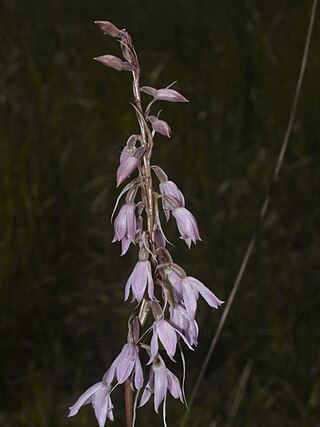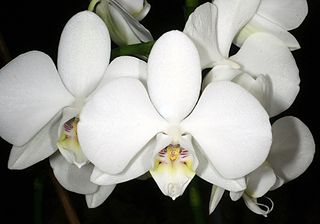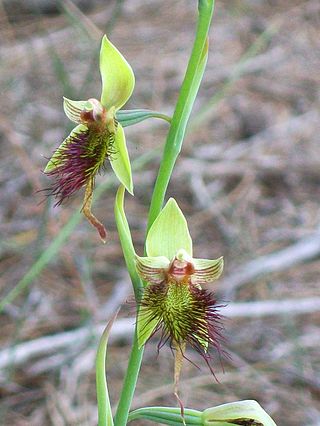
Cymbidium, commonly known as boat orchids, is a genus of evergreen flowering plants in the orchid family Orchidaceae. Orchids in this genus are epiphytic, lithophytic, terrestrial or rarely leafless saprophytic herbs usually with pseudobulbs. There are usually between three and twelve leaves arranged in two ranks on each pseudobulb or shoot and lasting for several years. From one to a large number of flowers are arranged on an unbranched flowering stem arising from the base of the pseudobulb. The sepals and petals are all free from and similar to each other. The labellum is significantly different from the other petals and the sepals and has three lobes. There are about fifty-five species and sixteen further natural hybrids occurring in the wild from tropical and subtropical Asia to Australia. Cymbidiums are well known in horticulture and many cultivars have been developed.

Pachystoma, commonly known as kunai orchids or 粉口兰属 , is a genus of two species of flowering plants in the orchid family, Orchidaceae. They are deciduous, terrestrial herbs with one or two linear, pleated or veiny leaves and more or less drooping flowers which do not open widely, on a thin, wiry flowering stem. Species in this genus are found in tropical and subtropical Asia to Australia and islands of the southwest Pacific Ocean.

Phalaenopsis amabilis, commonly known as the moon orchid, moth orchid, or mariposa orchid, is a species of flowering plant in the orchid family Orchidaceae. It is widely cultivated as a decorative houseplant. It is an epiphytic or lithophytic herb with long, thick roots, between two and eight thick, fleshy leaves with their bases hiding the stem and nearly flat, white, long-lasting flowers on a branching flowering stem with up to ten flowers on each branch.

Epipogium, commonly known as ghost orchids, is a genus of four species of terrestrial leafless orchids in the family Orchidaceae. Orchids in this genus have a fleshy, underground rhizome and a fleshy, hollow flowering stem with small, pale coloured, drooping, short-lived flowers with narrow sepals and petals. They are native to a region extending from tropical Africa to Europe, temperate and tropical Asia, Australia and some Pacific Islands.

Crepidium, commonly known as 沼兰属 or spur orchids is a genus of about three hundred species of orchids in the family Orchidaceae. Plants in this genus are evergreen, mostly terrestrial plants with short stems lying on the ground, two or more relatively large, pleated leaves and small, non-resupinate flowers with spreading sepals and petals. The genus is widely distributed in the tropics.

Aphyllorchis, commonly known as pauper orchids or as 無葉蘭屬/无叶兰属 , is a genus of about twenty species of terrestrial leafless orchids in the family Orchidaceae. Orchids in this genus have fleshy, upright stems and small to medium-sized resupinate flowers with narrow sepals and petals. They are native to a region extending from India east to China and Japan, south to Indonesia, New Guinea and Queensland.

Trichoglottis, commonly known as cherub orchids or 毛舌兰属 , is a genus of flowering plants in the family Orchidaceae. Orchids in this genus are epiphytic plants with thick roots, relatively thick, fibrous stems and many large, thick, leathery leaves arranged in two ranks. The flowers are usually small and yellowish with light brown or purple markings. The flowers have broad sepals, narrower petals and a labellum which has three lobes and is often hairy. There are about 85 species distributed from tropical and subtropical Asia to the north-western Pacific. Most species grow in rainforest.

Cheirostylis, commonly known as fleshy jewel orchids or velvet orchids, is a genus of about sixty species of flowering plants in the orchid family Orchidaceae. Plants in this genus are terrestrial herbs with a caterpillar-like rhizome and a loose rosette of leaves. Small, white, hairy flowers develop as the leaves wither. They are found in tropical Africa, southern Asia, Southeast Asia, Malesia, New Guinea and Australia.

Taeniophyllum, commonly known as ribbon roots or 带叶兰属 is a genus of about 240 species of epiphytic or lithophytic plants from the orchid family, Orchidaceae. Plants in this genus are more or less leafless with a very short stem and roots that are often flat, green and photosynthetic. The flowers are small, short-lived, flat or tube-shaped and arranged on short, thin flowering stems. Orchids in this genus are found in Africa, tropical and subtropical Asia, New Guinea, Australia and some Western Pacific Islands. It is extinct in Malawi.

Octarrhena, commonly known as grub orchids, is a genus of flowering plants from the orchid family, Orchidaceae. Plants in this genus are small, orchids with short stems, thin roots, short, thick, fleshy leaves arranged in two ranks and tiny flowers. The labellum is rigidly attached to the base of the column. There are about fifty species native to areas from Sri Lanka and Malesia to the Western Pacific.

Calochilus paludosus, commonly known as the red beard orchid or red beardie, is a species of orchid native to Australia and New Zealand. It has a single fleshy, light green leaf and up to nine greenish flowers with reddish stripes. The labellum has a dull red or coppery coloured beard and lacks the "eye" spots of other beard orchids.

Habenaria chlorosepala, commonly known as the green-hooded rein orchid, is a species of orchid that is endemic to a small area in far north Queensland. It has two or three leaves at its base and up to twenty small green and white flowers.

Habenaria exilis, commonly known as the wispy rein orchid, is a species of orchid that is endemic to a small area in far north Queensland. It usually has two leaves at its base and up to fifteen tiny whitish flowers.
Habenaria ferdinandi, commonly known as the yellow rein orchid, is a species of orchid that is endemic to the Northern Territory. It usually has two leaves at its base and up to fifteen tiny yellowish green, strongly scented flowers.
Habenaria harroldii, commonly known as the southern rein orchid, is a species of orchid that is endemic to the Fraser Coast region of Queensland. It has up to five leaves at its base and up to twenty five white flowers with reduced side lobes on the labellum.
Habenaria hymenophylla, commonly known as the coastal rein orchid, is a species of orchid that is endemic to northern Australia. It up to eight leaves scattered along the stem and up to thirty smelly green and white flowers.

Habenaria rumphii, commonly known as the stiff rein orchid, is a species of orchid that is widespread and common in Southeast Asia, New Guinea and northern Australia. It has six or seven leaves on the lower part of its stem and up to thirty white flowers with one long and two short lobes on the labellum.
Habenaria macraithii, commonly known as the whiskered rein orchid, is a species of orchid that is endemic to a small area in far north Queensland. It has up to eleven scattered leaves and up to twenty five relatively large green flowers with thread-like petal lobes.
Habenaria triplonema, commonly known as the twisted rein orchid, is a species of orchid that is endemic to northern Australia. It two or three leaves at its base and up to twenty five yellowish, strongly scented flowers.

Habenaria xanthantha, commonly known as the freak rein orchid, is a species of orchid that is endemic to far northern Queensland. It has two or three leaves at its base, and up to twenty small white flowers often lacking the nectary spur present on other species in the genus.















